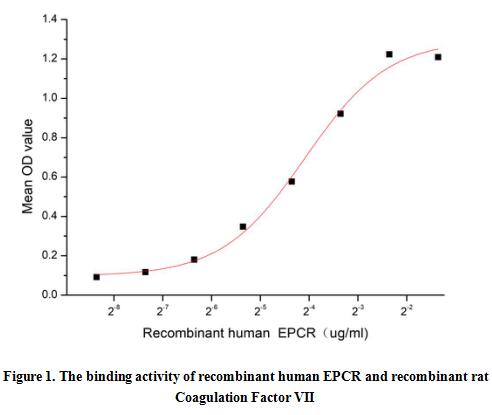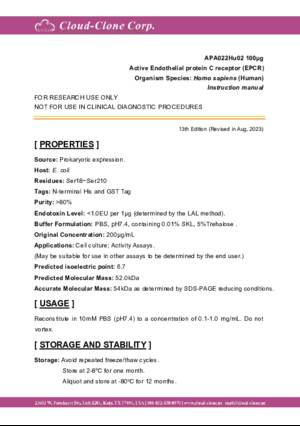Active Endothelial protein C receptor (EPCR)
CD201; PROCR; CCCA ;CCD41; BA42O4.2; EPCR; Endothelial Protein C Receptor; Cell Cycle, Centrosome-Associated Protein; Activated Protein C Receptor
- Product No.APA022Hu02
- Organism SpeciesHomo sapiens (Human) Same name, Different species.
- Buffer FormulationPBS, pH7.4, containing 0.01% SKL, 5% Trehalose.
- Traits Freeze-dried powder
- Purity> 80%
- Isoelectric Point6.7
- ApplicationsCell culture; Activity Assays.
- DownloadInstruction Manual
- UOM 10µg50µg 200µg 1mg 5mg
- FOB
US$ 196
US$ 490
US$ 980
US$ 2940
US$ 7350
For more details, please contact local distributors!
ACTIVITY TEST

Endothelial protein C receptor (EPCR) also known as CD201, is a transmembrane glycoprotein expressed on vascular endothelial cells and functions as a negative regulator of thrombosis. It is expressed most strongly in the endothelial cells of arteries and veins in heart and lung. Mature human EPCR consists of a 193 amino acid (aa) extracellular domain (ECD), a 21 aa transmembrane segment, and a 7 aa cytoplasmic tail. Within the ECD, human EPCR shares 63% and 66% aa sequence identity with mouse and rat EPCR, respectively. EPCR inhibits thrombosis through its interactions with Protein C, activated Protein C (APC), and Coagulation Factors VII, and VIIa. Thus a functional binding ELISA assay was conducted to detect the interaction of recombinant human EPCR and recombinant rat Coagulation Factor VII (F7). Briefly, EPCR was diluted serially in PBS with 0.01% BSA (pH 7.4). Duplicate samples of 100 μl were then transferred to F7-coated microtiter wells and incubated for 1h at 37℃. Wells were washed with PBST and incubated for 1h with anti-EPCR pAb, then aspirated and washed 3 times. After incubation with HRP labelled secondary antibody for 1h at 37℃, wells were aspirated and washed 5 times. With the addition of substrate solution, wells were incubated 15-25 minutes at 37℃. Finally, add 50 µL stop solution to the wells and read at 450/630nm immediately. The binding activity of recombinant human EPCR and recombinant rat F7 was shown in Figure 1, the EC50 for this effect is 0.06 ug/mL.
USAGE
Reconstitute in 10mM PBS (pH7.4) to a concentration of 0.1-1.0 mg/mL. Do not vortex.
STORAGE
Avoid repeated freeze/thaw cycles. Store at 2-8°C for one month. Aliquot and store at -80°C for 12 months.
STABILITY
The thermal stability is described by the loss rate. The loss rate was determined by accelerated thermal degradation test, that is, incubate the protein at 37°C for 48h, and no obvious degradation and precipitation were observed. The loss rate is less than 5% within the expiration date under appropriate storage condition.
GIVEAWAYS
INCREMENT SERVICES
-
 BCA Protein Quantification Kit
BCA Protein Quantification Kit
-
 Molecular Mass Marker for Protein
Molecular Mass Marker for Protein
-
 Monoclonal Antibody Customized Service
Monoclonal Antibody Customized Service
-
 Polyclonal Antibody Customized Service
Polyclonal Antibody Customized Service
-
 Protein Activity Test Experiment Service
Protein Activity Test Experiment Service
-
 Electrophoretic Mobility Shift Assay (EMSA) Experiment Service
Electrophoretic Mobility Shift Assay (EMSA) Experiment Service
-
 Buffer
Buffer
-
 Lentivirus Packaging Experiment Service
Lentivirus Packaging Experiment Service
-
 Adenovirus Packaging Experiment Service
Adenovirus Packaging Experiment Service
-
 Real Time PCR Experimental Service
Real Time PCR Experimental Service
-
 Spike RBD Protein (S-RBD)
Spike RBD Protein (S-RBD)
-
 Protein G
Protein G
-
 Protein A
Protein A
| Magazine | Citations |
| ВЕСТНИК НОВЫХ МЕДИЦИНСКИХ ТЕХНОЛОГИЙ | СОВЕРШЕНСТВОВАНИЕ ЛЕЧЕБНО-ДИАГНОСТИЧЕСКИХ МЕРОПРИЯТИЙ ПРИ ГРИППЕ ВО ВРЕМЯ БЕРЕМЕННОСТИ Bulletin: E2015-1 |
| Experimental and Therapeutic Medicine | Unfractionated heparin protects the protein C system against lipopolysaccharide‑induced damage in vivo and in vitro 10.3892/etm.2017.5236 |
| Biomed Pharmacother | Effects and mechanisms of PSS-loaded nanoparticles on coronary microcirculation dysfunction in streptozotocin-induced diabetic cardiomyopathy rats Pubmed: 31715373 |
| BULLETIN OF EXPERIMENTAL BIOLOGY AND MEDICINE | Effect of Nitinol on Metabolic and Coagulation Activity of Endothelial Cells Culture 34542754 |
| Catalog No. | Related products for research use of Homo sapiens (Human) Organism species | Applications (RESEARCH USE ONLY!) |
| APA022Hu02 | Active Endothelial protein C receptor (EPCR) | Cell culture; Activity Assays. |
| RPA022Hu01 | Recombinant Endothelial protein C receptor (EPCR) | Positive Control; Immunogen; SDS-PAGE; WB. |
| PAA022Hu01 | Polyclonal Antibody to Endothelial protein C receptor (EPCR) | WB; IHC; ICC; IP. |
| LAA022Hu71 | Biotin-Linked Polyclonal Antibody to Endothelial protein C receptor (EPCR) | WB; IHC; ICC. |
| MAA022Hu22 | Monoclonal Antibody to Endothelial protein C receptor (EPCR) | WB; IHC; ICC; IP. |
| SEA022Hu | ELISA Kit for Endothelial protein C receptor (EPCR) | Enzyme-linked immunosorbent assay for Antigen Detection. |
| LMA022Hu | Multiplex Assay Kit for Endothelial protein C receptor (EPCR) ,etc. by FLIA (Flow Luminescence Immunoassay) | FLIA Kit for Antigen Detection. |







